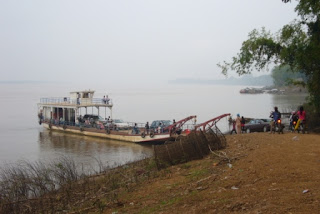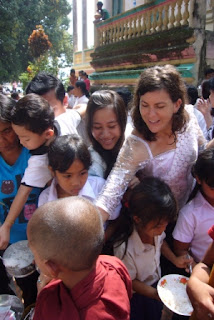Cambodia is noisy at the best of times but the recent funeral in the house behind our bedroom was a rude awakening like no other. A speaker stack with monks' chanting kicking off at 4am even managed to top
the 'ice man' from our first house. When someone dies here there are initially three days of mourning (and noise) followed by ceremonies to mark the death after seven days and 100 days.
(Turn up volume for full experience.)
Gilly was not happy last weekend when the funeral coincided with building works on both sides of the house (sampled above) as she tried to edit her dissertation. Adding to this was even more chanting from Kratie's pagodas in light of Pchum Ben (more on this later.).
We've had a building site on one side for some time but then a new one kicked off on the other side. In this case their main objective seemed to be using scaffolding to lift the house up for the insertion of a new ground floor, see below.
It wasn't just people dying. The welfare of the critically endangered Irrawaddy dolphin that lives in the Mekong about 15km North of town is carefully monitored by WWF. Their research into why the dolphins are dying is made challenging by a lack of dead specimens to examine. Over the last five months there has been a Spanish dolphin expert training the team in necropsy (an autopsy but performed on a different species than your own) and last week a fully grown adult (160kg!) was found and brought to the office for examination. This is obviously tragic for a species that numbers less than 80 but a small silver lining is that some data will become available and future discoveries can be professionally investigated to help find ways to halt their decline.

Fittingly, this weekend has marked the end of Cambodia's Pchum Ben holiday. This is 15 days, otherwise known as 'ancestor days', that signify the spirits of dead family members returning to earth. It was all a bit of a mystery to us so we were quick to accept an invitation from our surrogate family (a.k.a. our landlady) to go to her village (Preak Prasab) on the other side of the Mekong to mark the final day. (We did have
a brief brush with the event early on in our placement but weren't close enough to really understand it.)
First it was onto the ferry for the 15 minute journey to the 'West Bank', somewhere that, until today, we hadn't been in two years living here.
This guy has a portable key cutting business on the back of his moto. I was pleasantly surprised to find that his tin of metal was a brand close to my heart...
A lot of Pchum Ben revolves around food, just like Christmas back home. First up was breakfast which included coconut curry, salty fried pork, fried vegetables, bread and, of course, the obligatory rice.
Next the ladies had to change into their finery, the top is her own, the sash was on loan from our landlady. For men it's just the same clothes as any other day of the week ('tomeda' in Khmer, which means normal). I'm carrying a plate of fruit which will be offered up at the pagoda later. Out of shot is a stack of tiffin tins in Gilly's hand full of more food for offering.
Other than food, money plays a big role at Pchum Ben, as it does in most Cambodian ceremonies. The event seems to double as a bit of a fundraiser for the pagoda and this 'money tree' was one of a number of opportunities to part with some cash.
Here's a small selection of the food offerings originating in tiffin tins like the ones that Gilly was carrying. In return for our generosity we were blessed by the pagoda's monks over loudspeaker.
We also got to make a wish when we lit our incense. There were lots of wishes being made and a smoky atmosphere resulted.
The final part of the official ceremony at the pagoda was lining up to give the monks rice and money. This is part of the offering of food to the ancestors, many of whom can be hungry when they come back to earth. First, this woman comes around with a pan of water so that you can clean your serving spoon before the monks' arrival. Happiness at work is a wonderful thing!
Here are the monks walking slowly down the line to allow their bowls to be filled with rice and their plates covered with cash. Each monk has a young helper following him to scoop up the cash every now and then and deposit it into a large bag. There was also a team of men diligently emptying the rice bowls every so often to make space for the next round of spoonfuls along the line.
It was a bit of a bum rush to get your rice and money into the right places but a lot of fun all the same. Here's Gilly using her reach to good effect and, to the left, our landlady's daughter Navy doing her best to compete.
This was the end result of a few deposits from the rice collectors. It looks like the monks in this pagoda, and our collective ancestors, will be having a feast for days.
After all that formality is was time for a 'darlaing' (casual walk) and a photo shoot with Navy in the pagoda's gardens.
Death was the order of the day again on the way home where we stumbled upon the later stages of a cow being butchered. On the floor is its skin, the main meat has been taken away and all that's left are the various innards. I'm guessing the big thing is the four stomachs but these guys know best...
We finished off the morning before lunch with a 'family' photo, our landlord and landlady are in the back row.
It feels like today we've really understood something of Cambodian culture in contrast to our last brush with Pchum Ben as newcomers in 2010. We won't miss the noise it brings though. There is a pleasant stillness in the night as we tidy up this blog post and get ready for bed.
























.JPG)




.JPG)
.JPG)
.JPG)

















